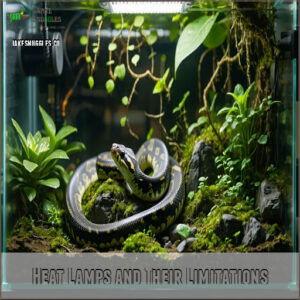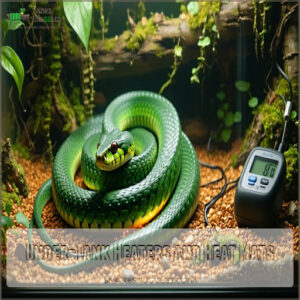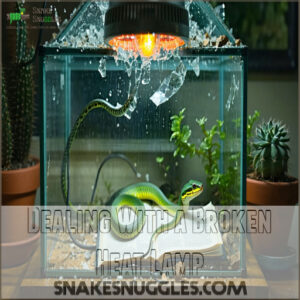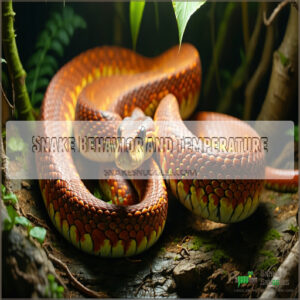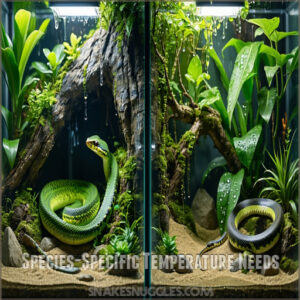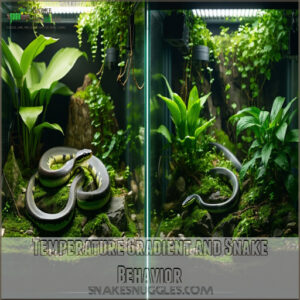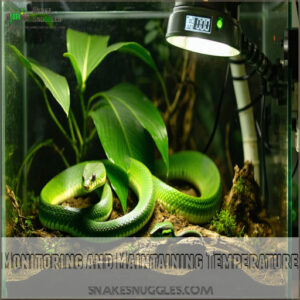This site is supported by our readers. We may earn a commission, at no cost to you, if you purchase through links.
 Snakes can survive without heat for a short time, but it depends on their species, size, and the surrounding temperature.
Snakes can survive without heat for a short time, but it depends on their species, size, and the surrounding temperature.
If it’s above 55°F, they might manage 6-12 hours without major harm.
However, snakes rely on warmth to digest food and stay active, so going days or weeks without heat can lead to stress, metabolic issues, or even infections.
Ball pythons, corn snakes, and other common pets have specific temperature needs, usually between 75-95°F.
Losing heat for too long is like being stuck without a coat in winter—not fun and potentially dangerous.
Quick fixes can help while you sort out heating solutions!
Table Of Contents
- Key Takeaways
- Snake Temperature Requirements
- Heating Options for Snakes
- Dealing With a Broken Heat Lamp
- Providing Heat Without a Lamp
- Snake Behavior and Temperature
- Species-Specific Temperature Needs
- Creating a Temperature Gradient
- Monitoring and Maintaining Temperature
- Frequently Asked Questions (FAQs)
- How long can a snake survive without a heat lamp?
- What temperature is too cold for snakes?
- How do you keep a snake warm without a heat lamp?
- How long can a snake stay dormant?
- How to keep a snake warm without a heat lamp?
- Do snakes need heat overnight?
- What happens if a snake gets too cold?
- How long can a ball python go without light?
- How long does it take for a snake to get hypothermia?
- Can a snake recover from prolonged exposure to low temperatures?
- Conclusion
Key Takeaways
- Snakes can usually go 4-6 hours without heat before risking lethargy or hypothermia, but prolonged cold exposure below 65°F is dangerous.
- You need to maintain a proper temperature gradient, as different snake species thrive between 75-95°F depending on their ideal needs.
- Use tools like heat mats, ceramic heat emitters, and insulated enclosures as alternative heat sources when needed.
- Monitor enclosure temperatures with thermometers and adjust consistently to prevent cold stress or heat deprivation.
Snake Temperature Requirements
Snakes rely on external heat sources to regulate their body temperature and maintain essential functions like digestion and metabolism.
Providing a proper temperature gradient in their enclosure is critical to mimic their natural environment and keep them healthy.
Understanding Temperature Gradients
A temperature gradient is key for meeting your snake’s temperature needs.
Think of it as creating cozy zones: warmer on one side, cooler on the other.
Use heat sources like mats or ceramic emitters and decorations like rocks to distribute warmth.
For effective health, consider species-specific temperature needs.
This thermal cycling lets your snake thermoregulate effectively, moving between zones for effective control of their body temperature and health, through thermal cycling.
Ideal Temperature Ranges for Different Species
Snakes thrive when their environment mimics their natural thermal gradient.
Each species has its own temperature tolerance tied to its physiology:
- Ball pythons: 77-86°F, with a basking spot of 90-95°F.
- Corn snakes: 75-85°F, needing basking areas around 85-90°F.
- Darwin carpet pythons: 77-86°F, with basking spots reaching 90-95°F.
- Garter snakes: 75-85°F, basking at 85-90°F.
- Kingsnakes: Most prefer 75-85°F, basking at 85-90°F.
Desert species adjust to fluctuating warmth, while tropical needs demand steady heat.
Knowing your snake’s ideal temperature range keeps digestion, metabolism, and activity in check, ensuring their health and happiness.
Never skimp on researching their thermal needs!
Consequences of Inadequate Heating
Without proper heat, a snake’s health can spiral fast.
Prolonged cold shock or temperature fluctuations can cause metabolic issues, respiratory infections, or even organ failure. Hypothermia risk increases as body functions slow, leaving your pet lethargic, vulnerable, and unable to digest food.
Heat stress isn’t just about warmth—it’s survival!
| Problem | Cause | Consequence |
|---|---|---|
| Respiratory Issues | Cold, immune suppression | Infection, breathing problems |
| Metabolic Issues | Low energy, poor digestion | Growth delays, deformities |
| Thermal Damage | Acute cold or heat exposure | Burns, scarring, organ failure |
| Lethargy | Inadequate heat | Weakness, inactivity |
| Illness Risk | Immune system compromise | Serious, life-threatening harm |
Snake survival without heat is limited—act quickly!
Heating Options for Snakes
Providing proper heat sources for your snake is essential to mimic its natural environment and keep it healthy.
You can choose from heat lamps, under-tank heaters, or ceramic emitters, each offering specific benefits for maintaining stable temperatures, and it is crucial to select the right one to ensure the well-being of your snake, by maintaining stable temperatures.
Heat Lamps and Their Limitations
Heat lamps are a go-to snake heat source but come with risks.
Be cautious of fire hazards, overheating, or burns to your snake.
Here’s what to evaluate:
- Lamp Safety: Make sure secure placement.
- Heat Distribution: Provides surface warming only.
- Energy Efficiency: Consumes significant power.
- Temperature Control: Can cause uneven heat.
- Replacement Costs: Expensive over time.
Under-Tank Heaters and Heat Mats
Creating a proper thermal gradient is essential for your snake’s health.
Heat mats and under-tank heaters are excellent heat source options to meet snake heat requirements. You can find a variety of snake heat mat products online.
They’re highly efficient but need proper placement for effective thermal control. Make sure the heater is used safely:
- Under the tank: Best for small setups, but monitor for overheating.
- Inside the tank: Ideal for large enclosures, paired with insulation.
- Partially wrapped around the tank: Great for maintaining steady temperature zones.
Always use thermostats to guarantee safe snake thermoregulation!
Ceramic Heat Emitters and Heat Pumps
Looking for reliable heat sources? Ceramic heat emitters provide safe, consistent warmth without light, great for calming nocturnal snakes.
They offer precise heating with energy efficiency and controlled thermal outputs. Consider a ceramic heat emitter product for your snake’s enclosure.
Heat pumps, ideal for multiple enclosures, maintain stable ambient temperatures, complementing emitters. Prioritize emitter safety—use thermostats to prevent overheating while creating a thermal gradient that’s healthy and comfortable for your snake, ensuring a safe and consistent warmth.
Dealing With a Broken Heat Lamp
When your heat lamp breaks, it’s important to act fast to keep your snake safe from temperature drops.
With a few emergency steps, like using heat mats or insulating the enclosure, you can help maintain a stable environment until the lamp is replaced.
This approach ensures your snake’s safety by providing an alternative heating solution, thus preventing potential harm from temperature drops.
Short-Term Solutions for Maintaining Temperature
Lost heat lamp? It’s time to improvise.
Use a heat mat or ceramic heat emitter as a backup heating method. Cover your snake’s enclosure with towels or blankets to improve heat retention, but avoid sealing airflow.
Hot water bottles wrapped in cloth are also quick fixes.
Maintaining appropriate species-specific temperatures is essential for reptile health.
Always monitor temperatures carefully and prioritize your snake’s safety—backup heating safeguards their survival!
Risks of Overheating and Hypothermia
When your snake’s heat lamp stops working, thermal stress becomes a real concern.
These coldblooded creatures face two major threats: heat stress and cold shock.
Here’s what to monitor:
- Overheating Warning Signs: Rapid breathing, unusual restlessness, and tongue flicking
- Hypothermia Risks: Sluggish movement, refusing food, and seeking warmth
- Temperature Extremes: Keep a thermometer handy to track habitat temps and prevent heat deprivation
Stress on The Snake and Urgent Action Needed
During heat deprivation, your snake will show clear signs of cold stress through reduced activity and appetite loss.
Heat shock can occur if you warm them too quickly, while snake hypothermia develops from prolonged exposure to cold.
Watch for dangerous symptoms like lethargy or respiratory issues, which demand emergency care.
For thermal recovery, gradually increase temperature and monitor your pet closely for signs of thermal stress.
Providing Heat Without a Lamp
You’ll find several effective alternatives to heat lamps that can keep your snake warm and healthy, including heat mats and ceramic heat emitters.
While your snake can survive without heat for 4-6 hours in an emergency, you’ll need to set up a reliable heat source quickly to prevent health issues.
Using Heat Mats and Ceramic Heat Emitters
Two reliable heat source options stand ready when your lamp fails. Heat mats and ceramic emitters provide essential warmth for your serpentine friend.
Here’s what makes these alternatives shine:
- Undertank heaters create a steady thermal gradient from below, perfect for belly heat
- Ceramic heat emitters last longer than traditional bulbs and won’t disturb sleep cycles
- Heat mats use less energy while maintaining consistent temperatures
These options, including ceramic emitters, are designed to ensure your pet’s comfort and well-being.
Insulation and Temperature Monitoring
While maintaining proper heat sources is essential, effective temperature control depends on smart insulation and monitoring.
By adding thermal mass materials like foam board or Reflectix around your enclosure, you’ll create a stable environment for your scaly friend.
Here’s what you need to know about different insulation approaches and their effectiveness:
| Material | Heat Retention | Cost-Effectiveness |
|---|---|---|
| Foam Board | High (8-12 hrs) | $$ |
| Reflectix | Very High (12-24 hrs) | $$$ |
| Bubble Wrap | Medium (4-6 hrs) | $ |
| Cork Panels | High (10-14 hrs) | $$$$ |
| Reptile Carpet | Low (2-4 hrs) | $ |
Place digital thermometers at both warm and cool ends to track your thermal gradient effectively, ensuring a proper temperature control system is in place.
Seeking Professional Help and Long-Term Solutions
Professional consultation becomes essential when facing prolonged heat deprivation in your snake’s habitat.
During a power outage or equipment failure, here’s who to contact:
- Veterinary care specialists for immediate health assessments
- Emergency services with reptile expertise for critical situations
- Heat recovery experts who understand snake rehabilitation
- Local herpetologists for species-specific guidance
- Backup power supply technicians for long-term solutions
Let’s guarantee your snake’s survival with expert help, ensuring you receive the right guidance and support for your snake’s specific needs.
Snake Behavior and Temperature
You’ll notice your snake’s activity level changes based on the temperature, as these cold-blooded creatures rely completely on external heat to stay active and healthy.
Without proper heat, your snake’s metabolism slows down quickly, and they can only survive between 6 to 12 hours at room temperature before experiencing serious health risks.
Brumation and Winter Dormancy
Your snake’s winter behavior includes a fascinating process called brumation, nature’s version of hibernation.
During this period, snakes enter a state of dormancy to conserve energy when temperatures drop.
Maintaining proper temperature control is essential for their well-being, even during brumation.
The brumation period typically lasts 2-4 months, requiring careful monitoring of seasonal lighting cycles and humidity levels.
Success depends on maintaining consistent conditions and following your snake’s natural cold adaptation rhythms.
Temperature and Activity Levels
Have you ever noticed how your snake’s activity changes with temperature? Understanding thermoregulation is key to keeping your pet healthy and active. Like tiny solar-powered creatures, snakes rely entirely on external heat to power their daily activities.
When temperatures drop, your snake’s metabolic rate slows dramatically, leading to reduced activity patterns and potential cold stress. Heat deprivation can seriously impact their survival, making ideal snake temperature essential for their well-being.
- Active snakes need temperatures between 75-95°F for proper digestion and movement
- Cold tolerance varies by species, with some handling brief drops to 65°F
- During their brumation period, snakes naturally slow down but still need minimal heat
- Sudden temperature changes stress snakes more than gradual shifts
- Heat-seeking behavior indicates your snake is trying to regulate its body temperature
Most snakes show peak activity when their environment matches their preferred temperature zone, typically 80-90°F. At these temperatures, they’ll explore, hunt, and behave normally, demonstrating the importance of external heat for their daily activities and overall health.
Humidity and Temperature Interactions
Your snake’s well-being depends on the delicate dance between temperature and humidity.
Heat stress can occur when these factors aren’t balanced properly.
Here’s how they interact:
| Environment | Low Humidity | High Humidity |
|---|---|---|
| Hot Temp | Scale damage | Respiratory issues |
| Cold Temp | Dehydration | Scale rot |
Creating the right thermal gradient while managing moisture levels helps prevent temperature fluctuations and supports proper thermoregulation.
Think of it as maintaining your reptile’s personal climate control system.
Species-Specific Temperature Needs
You’ll find that different snake species have unique temperature requirements, with ball pythons needing warmer basking spots around 90°F while corn snakes can thrive at slightly cooler temperatures near 85°F.
Your snake’s specific heating needs will determine how long it can safely go without heat, as tropical species like green tree pythons are more sensitive to temperature drops compared to hardier species like boa constrictors.
Ball Python Temperature Requirements
Your ball python’s thermal management needs careful attention to thrive. Create a temperature gradient between 75-95°F, with the basking spot reaching 90°F for ideal snake physiology.
- Use ceramic heat emitters or heat mats for consistent warmth
- Monitor temperatures daily with reliable thermometers
- Provide multiple hideouts across temperature zones
- Maintain 60% humidity while managing heat sources
This precise temperature control helps prevent stress and supports healthy digestion, which is crucial for the snake’s overall well-being, especially in terms of temperature control and healthy habits.
Corn Snake Temperature and Lighting Needs
Like their python cousins, corn snakes need specific temperature zones to thrive.
Your corn snake’s health depends on carefully managed heat and lighting that mimics their natural environment.
Here’s what you’ll need to maintain ideal snake temperature throughout their enclosure:
| Temperature Zone | Day | Night | Heat Source | Monitoring Tool |
|---|---|---|---|---|
| Basking Spot | 85-90°F | 70-75°F | Ceramic Lamp | Temp Gun |
| Warm Side | 80-85°F | 68-72°F | Heat Mat | Thermometer |
| Cool Side | 75-80°F | 65-70°F | None | Thermometer |
| Hide Box | 78-82°F | 68-72°F | Indirect Heat | Probe |
| Ground Level | 75-80°F | 65-70°F | UTH | Thermostat |
You’ll want to maintain a 12-hour light cycle using UVB lighting to support their natural behaviors and overall well-being.
Other Species and Their Temperature Requirements
While corn snakes manage well in moderate conditions, other species have distinct temperature requirements based on their natural habitats.
Desert species like rosy boas thrive in warmer environments, while tropical needs differ for species like green tree pythons.
Here’s what different snakes need:
- Ball pythons: 80-85°F ambient, 88-92°F basking spot
- Boa constrictors: 78-82°F ambient, 86-90°F basking area
- Kingsnakes: 75-80°F ambient, 85-88°F basking zone
- Garter snakes: 72-76°F ambient, 82-85°F basking region
Creating a Temperature Gradient
You’ll need to create different temperature zones in your snake’s enclosure, just like the varying temperatures they experience in nature.
Setting up a proper temperature gradient helps your snake regulate its body temperature by moving between warmer and cooler areas, which is essential for their health and daily activities, including maintaining a stable body temperature through a process that is essential for their well-being.
Using Rocks, Logs, and Other Decorations
Now that you understand different snake species’ needs, let’s explore how decorations create perfect thermoregulation zones.
Strategically placed rocks and logs act as thermal mass, storing and releasing heat throughout your snake’s enclosure.
Position heat rocks near the warm end, while natural hide boxes offer cooler retreats.
Your decorations shouldn’t just look good – they’re working hard to maintain that thermal gradient your snake needs for healthy living.
Temperature Gradient and Snake Behavior
After setting up your snake’s habitat decorations, you’ll notice fascinating behavioral patterns tied to temperature gradients.
Snakes actively seek different temperature zones throughout the day for thermoregulation. In warmer areas, they’ll display increased activity and better feeding responses, while cooler spots help them digest and rest.
This natural movement between temperature zones mimics their wild behavior and reduces cold stress.
Maintaining a Stable Temperature Gradient
Maintaining stable thermal gradients means strategic placement of heat sources to create warm and cool zones your snake can access.
Ball pythons thrive with proper temperature gradients.
You’ll want to position thermometers at both ends of the enclosure to monitor temperature variations.
Adding proper insulation, like cork bark or thick substrate, helps prevent unwanted fluctuations, think of it as creating a temperature map – your snake will naturally move between zones to regulate its body heat.
This approach allows for the creation of warm and cool zones where your snake can access different temperatures, which is crucial for strategic placement of heat sources.
Monitoring and Maintaining Temperature
You’ll need to keep a close eye on your snake’s temperature using reliable thermometers placed at both the warm and cool ends of the enclosure.
Your snake’s life depends on maintaining the right temperature range, so you should check the readings at least twice daily and adjust the heating equipment whenever needed, as this is crucial for your snake’s well-being and life.
Using Thermometers and Temperature Guns
You’ve mastered creating warm zones – now let’s make sure they’re perfect for your scaly friend. Getting accurate temperature readings is like having a personal weather station for your snake.
Consider a snake temperature gun purchase for convenient spot-checking. This allows for quick temperature checks and can be very useful.
- Digital thermometers offer quick, reliable readings for daily checks
- Infrared temperature guns let you measure specific spots without disturbing your snake
- Analog thermometers work as reliable backups if digital ones fail
- Probe thermometers monitor basking spots continuously
- LCD displays make nighttime temperature checks easier
Position your thermometers strategically – one at the basking area and another in the cool zone. Regular accuracy checks and proper calibration maintain your readings stay trustworthy.
Monitoring Temperature Fluctuations
Tracking temperature fluctuations is key to meeting snake temperature needs.
Use thermometers and temperature guns daily, logging data to spot trends. Calibrate devices often to maintain accuracy.
To reduce swings, focus on insulation, stable heat sources, and balanced thermal cycles.
Minimizing cold stress and heat deprivation keeps thermoregulation steady, supporting snake survival, even near minimum snake temperature limits.
Adjusting Heating and Cooling Systems
To maintain your snake’s temperature needs, fine-tune your thermostat settings and test your heat sources regularly.
Inspect cooling systems to avoid overheating and confirm insulation methods, like covering enclosures, minimize heat loss during cooler periods.
Creating a proper thermal gradient is essential for your snake’s well-being.
For snakes in brumation, stable temperature control is critical.
Remember, no heat snake survival depends on avoiding prolonged heat deprivation or a drop below the minimum snake temperature, which is crucial for snake survival.
Frequently Asked Questions (FAQs)
How long can a snake survive without a heat lamp?
Snakes can generally survive 4-6 hours without a heat source before risks like lethargy or hypothermia arise.
At room temperatures above 70°F, survival stretches to a couple of days, but long-term cold is dangerous.
What temperature is too cold for snakes?
Think of snakes like solar-powered machines—below 65°F, they risk health issues, with slowed metabolism and immune stress.
Prolonged exposure under 55°F can cause organ failure, so keeping their environment stable is critical.
How do you keep a snake warm without a heat lamp?
Wrap your snake’s enclosure with blankets to retain warmth.
Use hot water bottles or hand warmers placed safely outside the tank, and maintain a warm room temperature with a space heater for temporary heat support.
How long can a snake stay dormant?
When stillness meets survival, a snake can stay dormant for days or longer if temperatures remain stable but cool.
Cooler climates slow its metabolism, but prolonged dormancy risks health issues like immune decline or organ stress.
How to keep a snake warm without a heat lamp?
Use a heat mat, hot water bottles, or hand warmers wrapped in towels to keep your snake cozy.
Insulate the tank with blankets, and if needed, a space heater can raise the room’s temperature.
Do snakes need heat overnight?
A snake’s habitat needs warmth even at night.
While cooler temperatures overnight mimic nature, you shouldn’t let it drop too much.
Snakes require a stable range to prevent stress, digestion issues, and compromised immune health, as this is crucial for their overall well-being and prevent stress.
What happens if a snake gets too cold?
When a snake gets too cold, its metabolism slows, making it lethargic and unable to digest food.
Prolonged cold can cause respiratory infections, immune system issues, or even organ failure.
Warm it gradually to recover.
How long can a ball python go without light?
Bright bulbs aren’t essential for ball pythons, but they do need consistent heat.
They can go indefinitely without light as long as temperatures stay stable.
Light cycles help mimic natural environments, supporting their behavior and health.
How long does it take for a snake to get hypothermia?
Hypothermia in snakes can develop within a few hours if exposed to temperatures below their species-specific minimums.
Cold slows metabolism, causes lethargy, and risks organ failure, so quick action is important to prevent severe harm.
Can a snake recover from prolonged exposure to low temperatures?
It’s almost like surviving an icy tundra.
A snake can recover from prolonged cold exposure if you rewarm it gradually, maintain stable heat levels, and monitor for illness.
Immediate veterinary care boosts recovery chances greatly.
Conclusion
Keeping your snake warm is essential, like providing sunlight to a growing plant.
Without heat, your snake’s health, digestion, and activity rapidly decline. While some snakes can go 6-12 hours above 55°F, it’s risky to push their limits.
To avoid stress or illness, check the species’ ideal temperature range, and have reliable heating tools like mats or ceramic emitters. Always monitor temperature closely, because knowing how long a snake can go without heat could save its life.
- https://www.aussiepythons.com/threads/how-long-without-heating.217958/
- https://pangovet.com/pet-health-wellness/snakes/how-long-can-ball-pythons-go-without-heat/
- https://www.quora.com/How-long-can-a-ball-python-go-without-heat
- https://www.cornsnakes.com/forums/threads/need-to-soon-how-long-a-snake-be-alone-with-out-a-heat-lamp.53890/
- https://www.reddit.com/r/snakes/comments/l0tynv/how_long_can_my_snake_go_without_heat/


